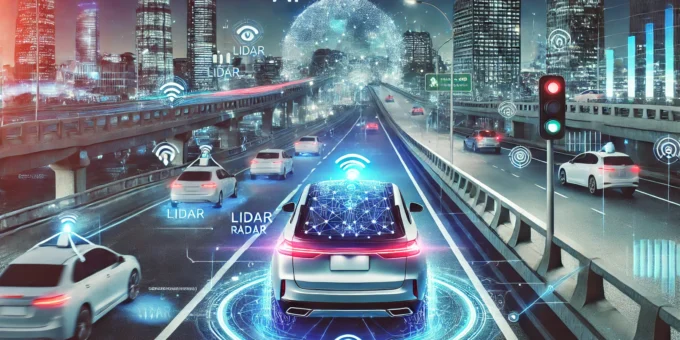
Introduction
Artificial Intelligence (AI) is at the heart of the self-driving revolution, transforming how vehicles perceive and navigate their environments. From Tesla’s Autopilot to Waymo’s fully autonomous vehicles, AI enables self-driving cars to make real-time decisions, improve road safety, and optimize efficiency.
This article explores the role of AI in self-driving cars, its impact on safety, machine learning applications, sensor technologies, challenges, and the future of autonomous transportation.
How AI Powers Self-Driving Cars
AI enables self-driving cars to process vast amounts of data from their surroundings, analyze potential hazards, and execute driving decisions just like a human driver—but with greater precision.
Key AI Technologies in Self-Driving Cars
- Machine Learning (ML) – Helps cars learn from data, improving decision-making over time.
- Computer Vision – Allows vehicles to “see” and identify objects, pedestrians, and road signs.
- Deep Learning – Enables neural networks to process vast amounts of visual and sensor data.
- Sensor Fusion – Integrates data from multiple sensors for accurate environmental understanding.
AI and Vehicle Perception: Seeing the Road Like a Human
For self-driving cars to navigate safely, they must accurately interpret their surroundings. AI replicates human perception using various sensors and algorithms.
Types of Sensors Used in Autonomous Vehicles
- Cameras – Capture images of road signs, traffic lights, and pedestrians.
- LiDAR (Light Detection and Ranging) – Uses laser pulses to create a 3D map of the environment.
- Radar – Detects objects and measures their speed and distance.
- Ultrasonic Sensors – Assist with parking and close-range obstacle detection.
By combining data from these sensors, AI can make informed decisions in real time, such as stopping for a pedestrian or adjusting speed based on traffic flow.
AI in Decision-Making and Path Planning
Self-driving cars rely on AI to analyze road conditions, predict traffic patterns, and make precise driving decisions.
How AI Makes Driving Decisions
- Perception Stage – AI identifies obstacles, lane markings, and other vehicles.
- Prediction Stage – AI anticipates the movement of other road users.
- Planning Stage – AI calculates the safest and most efficient route.
- Execution Stage – AI controls acceleration, braking, and steering.
For example, AI can predict when a pedestrian might step onto the road and slow down accordingly.
Enhancing Safety with AI in Self-Driving Cars
Safety is one of the primary goals of autonomous vehicles. AI reduces human error, which is responsible for over 90% of road accidents worldwide.
AI-Powered Safety Features
- Automatic Emergency Braking (AEB) – AI detects imminent collisions and applies brakes.
- Lane-Keeping Assistance – Prevents vehicles from drifting out of their lane.
- Adaptive Cruise Control (ACC) – Adjusts vehicle speed based on traffic conditions.
- Driver Monitoring Systems (DMS) – Ensures driver attentiveness in semi-autonomous vehicles.
These technologies work together to create a safer driving experience by minimizing risks and improving response times.
AI and Traffic Efficiency: Optimizing Road Networks
AI doesn’t just improve safety—it also enhances efficiency by reducing traffic congestion and optimizing fuel consumption.
AI’s Role in Traffic Management
- Smart Traffic Lights – AI-powered signals adjust in real time based on traffic flow.
- Vehicle-to-Everything (V2X) Communication – Self-driving cars communicate with traffic infrastructure to reduce congestion.
- Eco-Friendly Driving – AI optimizes speed and route selection to reduce emissions and fuel consumption.
By integrating AI into city traffic systems, we can expect faster commutes and lower carbon emissions.
Challenges of AI in Self-Driving Cars
Despite AI’s advancements, autonomous vehicles face several hurdles before becoming mainstream.
Legal and Regulatory Issues
- Governments are still developing policies to address liability and ethical concerns.
- AI must comply with safety regulations and road laws in different countries.
Data Privacy and Cybersecurity
- Self-driving cars collect vast amounts of personal data, raising concerns about privacy.
- AI systems must be protected from cyberattacks that could compromise vehicle control.
Ethical Dilemmas in AI Decision-Making
- AI must be programmed to make life-and-death decisions in accidents.
- How should AI prioritize safety when a collision is unavoidable?
These ethical questions must be addressed to build public trust in autonomous vehicles.
The Future of AI in Self-Driving Cars
AI-driven cars are evolving rapidly, with major advancements expected in the coming years.
What’s Next for Autonomous Vehicles?
- Level 5 Autonomy – Fully self-driving cars with no human intervention.
- AI-Powered Ride-Sharing – Companies like Uber and Lyft will deploy AI-driven fleets.
- Smart Cities – AI will integrate with urban infrastructure for seamless traffic management.
- 5G and AI Connectivity – Faster communication between vehicles and road systems.
As AI technology improves, self-driving cars will become safer, more reliable, and widely adopted.